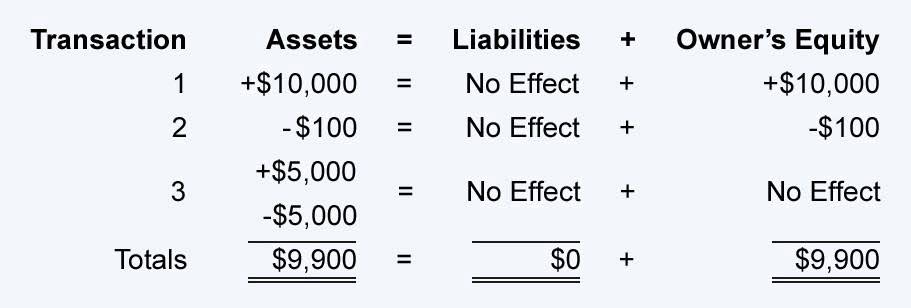
The income statement addresses your business’s operational efficiency, the balance sheet shows financial solidity, and the statement of owner’s equity details the narrative of your investment over time. When a company has negative owner’s equity and the owner takes draws from the company, those draws may be taxable as capital gains on the owner’s tax return. For that reason, business owners should monitor their capital accounts and try not to take money from the company unless their capital account has a positive balance. Tracked over a specific timeframe or accounting period, the snapshot shows the movement of cashflow through a business.

Statement of Owner’s Equity vs. Cash Flow Statement
Get instant access to video lessons taught by experienced investment bankers. Learn financial statement modeling, DCF, M&A, LBO, Comps and Excel shortcuts. However, the term “Owner’s Equity” is most commonly used in the context of a sole proprietorship—which is the simplest business structure—wherein the entity is managed by one business owner, like an entrepreneur. Simply put, the owner’s equity is the Bookkeeping for Veterinarians remaining value attributable to the owner in the event of a hypothetical liquidation, in which the leftover funds are returned to the business owner. A positive number indicates that your company has more assets than debts, while a negative number suggests more debts than assets. Before calculating, ensure you have your company’s most recent balance sheet.

Calculating Owner’s Equity: A Step-by-Step Approach
- On the other hand, shareholders’ equity consists of items such as common stock, preferred stock, additional paid-in capital (APIC), and treasury stock.
- For more, see our tutorial on Noncontrolling Interests and consolidation accounting.
- These examples demonstrate how various financial activities during the year affect the owner’s equity.
- Corporations use a shareholder’s or stockholder’s equity statement, which are more complex and involve dividends and stock components.
- Our team is ready to learn about your business and guide you to the right solution.
- At first blush, the equity on a balance sheet and the owner’s equity statement may look like they’re playing the same tune, but in essence, they perform a duet with crucial differences.
- The only difference between owner’s equity and shareholder’s equity is whether the business is tightly held (Owner’s) or widely held (Shareholder’s).
This important business tool determines overall financial health and stability of your business. The equity statement indicates if a small business owner needs to invest more capital to cash flow cover shortfalls, or if they can draw more profits. A statement of owner’s equity is a one-page report showing the difference between total assets and total liabilities, resulting in the overall value of owner’s equity.
Examples
- It is not intended to provide specific financial, investment, tax, legal, accounting, or other advice and should not be acted or relied upon without the advice of a professional advisor.
- Remember from earlier lessons that current assets and current liabilities are often amounts that are settled in one year or less.
- In this example, the company raised an amount of $10,000 and also earned an income of $20,000.
- It helps you make informed decisions about future investments, business expansion, or when it might be time to tighten the purse strings.
- The Statement of Owner’s Equity is one of the four major financial statements.
- The owner’s equity is recorded on the balance sheet at the end of the accounting period of the business.
The statement of owner’s equity typically includes the beginning equity balance, any additional owner contributions, net income or loss for the period, owner withdrawals or dividends, and ends with the final equity balance. It outlines how the business’s performance and owner transactions impact the owner’s stake in the company. The statement of owner’s equity is one of the the statement of owners equity is calculated as follows: shorter financial statements because there aren’t many transactions that actually affect the equity accounts.

On the contrary, investors may perceive it as a mixed signal from the company and hesitate to invest further. To summarise the examples mentioned above, we can categorize the effects on the Statement of Owner’s Equity into business transactions. Since net profit is the difference between income and expenses, the net income should increase the equity. These examples demonstrate how various financial activities during the year affect the owner’s equity. Owner’s Equity is the residual value of an owner’s claim on the assets of their respective business upon deducting total liabilities. Corporations are formed when a business has multiple equity ownership, but unlike partnerships, corporation owners are provided legal liability protection.
- One horizontal line means that a mathematical operation has been performed.
- Preferred stock, on the other hand, receives a fixed dividend that is paid before any dividends are paid to common stockholders.
- This is one calculation that many small business owners overlook as they don’t understand the value of monitoring to assess changes over time.
- If you look at the balance sheet, you can see that the total owner’s equity is $95,000.
- If there had been a loss instead of net income (if expenses had exceeded revenues), that loss would have been subtracted from the capital and would be noted with parentheses.
- Regardless of the type of dividend, the declaration always causes a decrease in the retained earnings account.